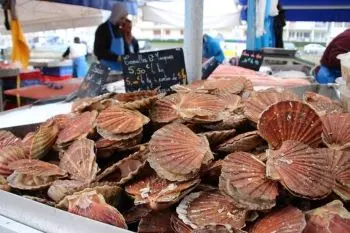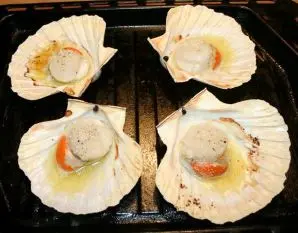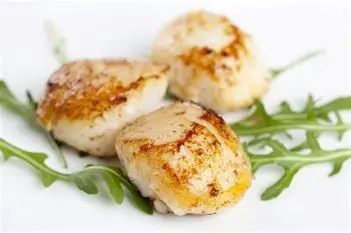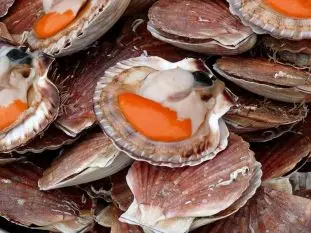This site uses only a few technical cookies necessary for its operation. By continuing to browse, you accept their use.
To find out more...
To find out more...
Cooking scallops

We are, as I write these lines, in the season of the scallops, if you like that it is necessary to benefit from it as much as possible, although it is alas not cheap.
I like scallops a lot, but I have to admit that it has naturally little taste, or, said differently, it takes the taste of what you cook it in, but it takes it well!
That's why cooking scallops with cream of sorrel for example, started in butter if possible, is absolutely delicious because the scallop, or rather the nut, goes very well with its sauce and the cooking material.
I like scallops a lot, but I have to admit that it has naturally little taste, or, said differently, it takes the taste of what you cook it in, but it takes it well!
That's why cooking scallops with cream of sorrel for example, started in butter if possible, is absolutely delicious because the scallop, or rather the nut, goes very well with its sauce and the cooking material.
13 K 5/5 (13 reviews)
Keywords for this post:CookingScallopsShellShellfishSeafoodPlanchaGrilledOvenLast modified on: November 23th 2021
Cooking scallops
If you prepare them, whatever the recipe, you will sooner or later be confronted with the problem of cooking.
And that's normal, that's the difficulty of preparation, and there are two main ways:
It is cooked on a hot surface without excess, or even in the oven, to preserve the pearly side already mentioned.
Of course they think that going further in cooking is a heresy, this school is very present in the chic restaurants.
At Robuchon's, in one of his books, the scallops are only cooked for 2 minutes in the oven.
Well, I don't hide from you that I have trouble with these short cooking times, but it is a school that respects itself.
The "burning" side plus "each side" gives very colorful and tasty nuts, but let's not forget the butter. By the way, the plancha is ideal for this cooking.
It should be done quickly if possible, otherwise an overcooked scallop becomes hard as a tennis ball.
Of course these are not the only cooking methods, you can consider many others such as in papillotes or poached for example, you just have to keep in mind that the scallops must be cooked, but not too much ...
Then, and whatever the chosen method, you have to think about 3 things:
1) Rinse the nuts well
2) Remove the "foot" (small hard part on the side of the scallop)
3) Dry the nuts (paper towel or cloth), top and bottom, before cooking them.
This is not always easy, but remember that you need "dry" nuts to start cooking, it always works better.
It's just a question of taste, personally I find it a bit dull and not very interesting, I don't keep them, but that's debatable.
In some old recipes, a bit dated, the coral is used separately to constitute a sauce base, a bit like a thickener, but it's the same observation, not much gustatory interest, rather aesthetic.
To sum up: cooking scallops is always a delicate matter, you have to be precise and relatively quick.
And that's normal, that's the difficulty of preparation, and there are two main ways:

It is cooked on a hot surface without excess, or even in the oven, to preserve the pearly side already mentioned.
Of course they think that going further in cooking is a heresy, this school is very present in the chic restaurants.
At Robuchon's, in one of his books, the scallops are only cooked for 2 minutes in the oven.
Well, I don't hide from you that I have trouble with these short cooking times, but it is a school that respects itself.

The "burning" side plus "each side" gives very colorful and tasty nuts, but let's not forget the butter. By the way, the plancha is ideal for this cooking.
It should be done quickly if possible, otherwise an overcooked scallop becomes hard as a tennis ball.
Of course these are not the only cooking methods, you can consider many others such as in papillotes or poached for example, you just have to keep in mind that the scallops must be cooked, but not too much ...
Then, and whatever the chosen method, you have to think about 3 things:
1) Rinse the nuts well
2) Remove the "foot" (small hard part on the side of the scallop)
3) Dry the nuts (paper towel or cloth), top and bottom, before cooking them.
This is not always easy, but remember that you need "dry" nuts to start cooking, it always works better.

It's just a question of taste, personally I find it a bit dull and not very interesting, I don't keep them, but that's debatable.
In some old recipes, a bit dated, the coral is used separately to constitute a sauce base, a bit like a thickener, but it's the same observation, not much gustatory interest, rather aesthetic.
To sum up: cooking scallops is always a delicate matter, you have to be precise and relatively quick.
Lasts posts
Butter vs. grease
We often read in a recipe where a pastry is put into a mould that, just before pouring, the mould should be buttered or greased. But what's the difference between these 2 terms?December 1st 20256615
Getting out of the fridge early
Very often when you're cooking, you need to take food or preparations out of the fridge, to use them in the recipe in progress. There's nothing tricky about this: you just take them out of the fridge and use them, usually immediately, in the recipe. But is this really a good method?November 24th 20259615
Who's making the croissants?
When you look at a bakery from the outside, you naturally think that in the bakery, the bakers make the bread, and in the laboratory, the pastry chefs make the cakes. It's very often like that, with each of these professions having quite different ways of working, but sometimes there's also one...November 23th 2025863
Oven height
When we put a dish or cake in the oven, we naturally tend to put it on the middle shelf, and that's what we usually do. But in some cases, this position and height can be a little tricky, so let's find out why.October 8th 20252,4455
The importance of sieving
In recipes that use a fine powder (flour, powdered sugar, etc.), you'll often see the advice to sift before using it. To sift is to pass the powder in question through a sieve (a very fine strainer) before incorporating it into your recipe. It's often advice, but is it really useful?September 3rd 20257,3373
Other pages you may also like
Parmesan cheese crusts
If you use Parmesan cheese (Parmigiano Reggiano) in your recipes, you may have already noticed: when you grate it, it becomes (very) difficult near the crust, especially if it is a slightly aged parmesan, as the cheese gets harder and harder. So we stop grating, leaving some crust on top, and a...September 14th 202217 K4.8
How to zest a fruit?
You will have no doubt noticed that many recipes call for the zest of citrus fruit. The zest is that outer layer of the skin which adds so much flavour to a dish. There are many different ways to peel off the zest and various tools are available. Here is a summary of the “dos and don'ts” of...November 5th 201347 K3.8
Candied fruits: don't get ripped off
Do you like candied fruit? You might like to nibble a handful or add it to a recipe, like a classic fruit cake or delicious Italian specialities like panettone or sicilian epiphany pie.June 21th 201767 K 24.2
Foie gras service
For the upcoming christmas meals you too may be sacrificing to the tradition of foie gras? If so, I suggest you take a look at everything that revolves around serving foie gras: how to serve it, and what to eat and drink with it.December 23th 201716 K4.9
The 3 essential knives
You must have heard a chef or cook say: "There’s no good cooking without good ingredients". This is very true, of course, but for any amateur or beginner it is equipment that really counts to start with. What I mean is that you should not skimp on kitchen equipment, good utensils, a food...May 30th 201825 K5
Post a comment or question
Follow this page
If you are interested in this page, you can "follow" it, by entering your email address here. You will then receive a notification immediately each time the page is modified or a new comment is added. Please note that you will need to confirm this following.
Note: We'll never share your e-mail address with anyone else.
Alternatively: you can subscribe to the mailing list of cooling-ez.com , you will receive a e-mail for each new recipe published on the site.









